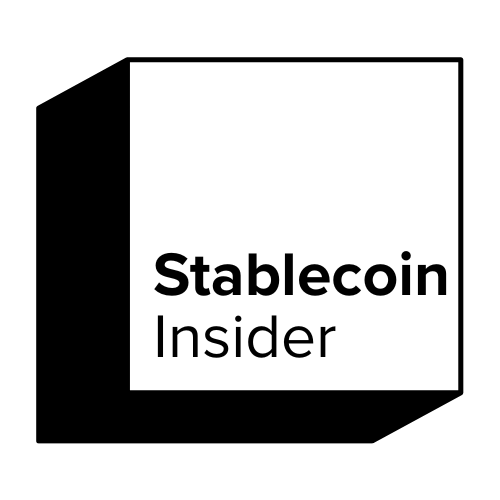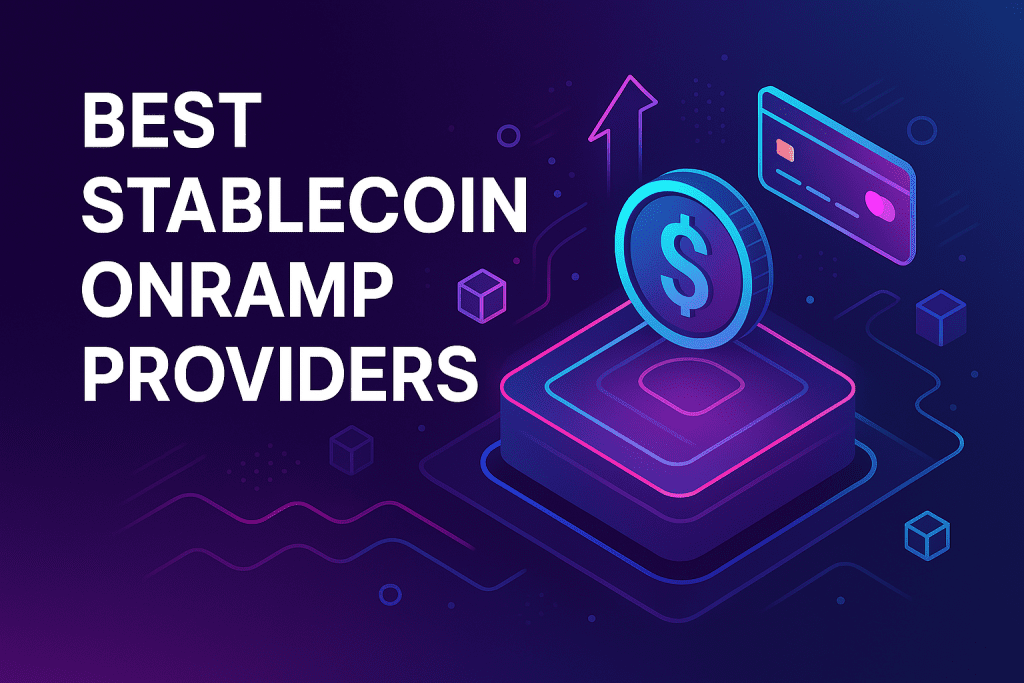Stablecoins have emerged as one of the most important innovations in the cryptocurrency ecosystem, offering the stability of traditional fiat currencies while maintaining the benefits of digital assets.
But for stablecoins to truly fulfill their potential—whether for remittances, savings, DeFi, or payroll—users must be able to acquire them easily. This is where stablecoin onramp providers come in.
Onramps serve as a bridge between traditional finance and the world of crypto. They enable users to purchase stablecoins like USDC or USDT using local fiat currencies through familiar payment methods such as credit cards, bank transfers, or mobile wallets.
A good onramp provider can make all the difference in the user experience—especially when regulatory clarity, speed, fees, and global accessibility are on the line.
Key Takeaways:
- Stablecoin onramps make it easy to convert fiat currency into stablecoins, powering DeFi, payroll, savings, and more.
- The best providers balance speed, low fees, global reach, strong compliance, and user-friendly interfaces.
- Businesses and developers should look for tools like APIs, SDKs, and compliance integrations.
What is a Stablecoin Onramp?
A stablecoin onramp is a service that allows users to convert fiat currencies (like USD, EUR, GBP) into stablecoins (such as USDC, USDT, or DAI). Unlike crypto exchanges that focus on trading, onramps are primarily designed to facilitate entry into the crypto ecosystem.
Key Roles:
- Support user onboarding via card, bank transfer, or local payment methods
- Enable wallets and dApps to offer fiat-to-stablecoin conversion
- Help businesses pay employees or contractors in stablecoins
Use cases include:
- Remote payroll
- DeFi investments
- Savings in digital dollars
- Global remittances
Criteria for Evaluating Stablecoin Onramp Providers
When evaluating a stablecoin onramp, users and businesses should consider the following:
- Supported Stablecoins: USDC, USDT, DAI, EUROC, and others
- Fiat Currency Compatibility: USD, EUR, GBP, NGN, BRL, INR, etc.
- Licensing and Compliance: Is the provider regulated in major jurisdictions?
- KYC/AML Requirements: Full KYC, tiered KYC, or no-KYC for small volumes?
- Transaction Fees: Fixed or percentage-based fees; hidden FX costs
- Speed: How long does it take to receive stablecoins?
- Payment Methods: Bank wire, credit/debit card, Apple Pay, Google Pay
- Developer Tools: API, SDK, webhooks, white-label support
- Customer Service: Is there responsive support for users?
Top Stablecoin Onramp Providers (2025)
1. MoonPay
Overview: MoonPay is a widely-used retail-focused crypto onramp that prioritizes user experience and accessibility. With a sleek interface and fast onboarding, it’s commonly integrated into wallets and NFT marketplaces.
- Supported Stablecoins: USDC, USDT
- Countries: Available in 160+ countries, including the US, EU, and much of Latin America
- Payment Methods: Credit/debit cards, Apple Pay, Google Pay, bank transfers (in select countries)
- Pros: Easy UI/UX, quick onboarding, seamless wallet integration
- Cons: High fees (up to 4.5%), less favorable exchange rates, some regions unsupported
- Best for: Retail users seeking speed and simplicity when buying small amounts of stablecoins
2. Ramp Network
Overview: Ramp is a non-custodial fiat-to-crypto infrastructure provider that integrates directly into apps and wallets. It’s known for being developer-friendly and compliant.
- Stablecoins: USDC, USDT, DAI, and more
- Licensing: FCA-registered (UK), EU-compliant, registered with FinCEN (US)
- Features: JavaScript SDK, REST API, Web3 wallet support, fiat payouts (offramp)
- Pros: Fast KYC, low fees, seamless Web3 integration
- Cons: Limited to supported fiat currencies
- Best for: Wallets, dApps, and fintech platforms needing regulatory-compliant infrastructure
3. Transak
Overview: Transak is a global Web3 onboarding solution offering both onramps and offramps with broad coverage across countries and blockchains.
- Payment Methods: Credit/debit cards, bank transfers, UPI (India), PIX (Brazil), Apple Pay
- Low KYC Threshold: Tiered KYC system allows small purchases without full verification
- Features: Supports 75+ fiat currencies and 100+ crypto assets across multiple chains
- Pros: Excellent international coverage, business dashboards
- Cons: Occasional delays during high volume
- Best for: Global Web3 projects and applications looking for wide coverage and low-barrier entry
4. Coinbase Pay / Coinbase Commerce
Overview: Operated by one of the largest and most trusted crypto exchanges, Coinbase’s onramp products cater to both individuals and businesses in the U.S.
- Pros: Deep integration with Coinbase accounts, strong regulatory compliance, accessible user interface
- Cons: Limited global availability, not ideal for non-Coinbase users
- Features: Easy plug-in for merchants, integrates with e-commerce platforms
- Best for: U.S.-based businesses, merchants, and users looking for a highly trusted provider
5. Stripe (USDC Support)
Overview: Stripe has added support for stablecoins (starting with USDC) on networks like Solana and Ethereum, offering onchain payments via its existing payment rails.
- Use Case: Embedding crypto payments in SaaS or platform ecosystems
- Pros: Enterprise-grade infrastructure, robust developer tools, seamless integration
- Cons: Limited to USDC and select platforms for now
- Best for: Large-scale Web3 platforms and SaaS companies embedding crypto payments into apps
6. Wert
Overview: Wert focuses on Web3 payments, NFTs, and metaverse applications, offering tailored services for digital asset commerce.
- Features: No custodial service; smart contract integration for NFT purchases
- Global Reach: Supports 120+ countries and dozens of fiat currencies
- Pros: Optimized for NFTs and metaverse use cases
- Cons: Niche product focus; less useful for general-purpose onramping
- Best for: NFT platforms, digital goods stores, and metaverse-related applications
7. Banxa
Overview: Banxa offers a fiat-to-crypto gateway with strong regulatory compliance and tailored business integrations.
- Supported Regions: Strong in Australia, Southeast Asia, and parts of Europe
- Compliance: Regulated in Canada, Australia, EU, and others
- Features: Business portals, API access, off-ramping, fraud prevention tools
- Pros: Deep customization for B2B; supports local payment methods
- Cons: UI could be more intuitive for retail users
- Best for: Enterprises and crypto platforms targeting regional markets with tailored solutions
8. Sardine
Overview: Sardine combines onramp services with advanced fraud prevention tools, making it unique among onramps.
- Unique Feature: Behavioral biometrics and transaction risk scoring
- Use Case: Fintech apps and crypto platforms seeking advanced fraud controls
- Pros: Powerful for compliance-heavy use cases; secure onboarding
- Cons: Enterprise-focused; less suited for casual users
- Best for: Regulated fintech apps, crypto neobanks, and compliance-first companies
9. Mercuryo
Overview: A fast-growing fintech company offering simple, fast stablecoin purchases with global reach and wide integration.
- Speed: Delivery in under 5 minutes in most regions
- Integration: Used by Trust Wallet, 1inch, Bitfinex, and others
- Payment Methods: Card, SEPA, SWIFT, Apple Pay
- Pros: User-friendly design, competitive rates, global reach
- Cons: KYC required for most users
- Best for: Crypto wallet users and developers wanting a plug-and-play solution
10. Alchemy Pay
Overview: Alchemy Pay focuses on enabling fiat-to-crypto payments in emerging markets through mobile and QR-code payments.
- Features: Accepts regional payment methods like GCash (Philippines), OVO (Indonesia), M-Pesa (Kenya)
- Reach: Strong presence in Asia, Africa, and Latin America
- Pros: Ideal for underbanked regions; mobile-first design
- Cons: Less coverage in the US and EU
- Best for: Web3 projects serving developing markets or mobile-first users Overview: Onramp with a focus on emerging markets
- Features: QR codes, mobile payments, broad fiat support
- Best for: Asia, Latin America, and Africa-focused apps
Emerging & Niche Onramp Providers to Watch
Loop Crypto
- Focused on B2B payments and Web3 payroll
- API-first experience
Mt Pelerin
- Based in Switzerland
- Offers non-custodial, KYC-light experience
Kriptomat
- European-friendly UI
- Strong EUR support
Swapin
- Focuses on EU bank-to-crypto rails
- Clean UI and strong compliance
Use Cases: Choosing the Right Onramp
For Individuals
- Prioritize ease of use and minimal KYC (MoonPay, Transak)
For Businesses
- Look for API access, high-volume limits, compliance (Ramp, Sardine, Banxa)
For DAOs/DeFi Protocols
- Need wallet-native integration and global reach (Ramp, Alchemy Pay)
For Developers
- Look for SDKs, white-labeling, and customizable flows (Transak, Ramp)
Regulatory Considerations
- Most top providers are now regulated in at least one major jurisdiction
- Ensure provider complies with the FATF Travel Rule and local KYC/AML
- Avoid unlicensed services that put users at risk of account freezes or fraud
Future Trends in Stablecoin Onramps
- AI-powered risk detection will reduce fraud and improve onboarding
- Underbanked market expansion will bring stablecoins to new users in Africa, Southeast Asia, and Latin America
- Neobanks with stablecoin rails will blur the lines between traditional and decentralized finance
- Layer 2 integrations will reduce gas fees and make stablecoin onramps more efficient
Conclusion
Stablecoin onramps are essential infrastructure in the growing digital economy. Whether you’re a casual user trying to buy USDC or a business scaling stablecoin payroll, there’s a solution for you.
Evaluate providers based on your specific needs—user experience, fees, regulatory compliance, developer tools, or global reach—and stay up to date as new platforms and features emerge.
Read Next:
FAQ: Stablecoin Onramps
What is the difference between an onramp and an exchange?
Onramps help users convert fiat currency to stablecoins. Exchanges allow users to trade between cryptocurrencies or between crypto and fiat.
Do I need KYC to use a stablecoin onramp?
Yes, most providers require KYC, though some allow small purchases without full verification.
Which stablecoin is the most supported?
USDC and USDT are the most widely supported across providers.
Can I use a stablecoin onramp without a crypto wallet?
Some providers let you create a wallet during onboarding, but you’ll generally need a wallet to receive your stablecoins.
Are stablecoin onramps safe?
Yes—when using reputable, licensed providers. Always do your own research and avoid unknown or unlicensed platforms.
What are the fees involved?
Fees vary by provider and payment method. Expect transaction fees, potential FX fees, and blockchain gas costs.
Can businesses integrate onramps into their apps or platforms?
Yes. Many onramps like Ramp, Transak, and Sardine offer API and SDK access for seamless integrations.

